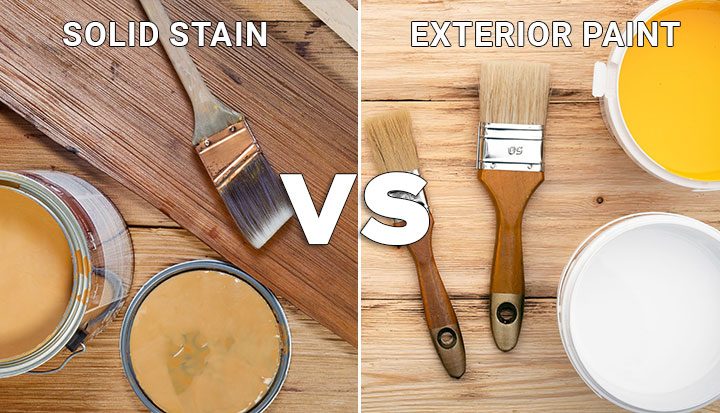Exterior Paint vs. Solid Stain: Understanding the differences
Homeowners are often faced with the decision of whether to use exterior paint or solid stain when it’s time to revamp their homes’ facades. Both exterior paint and solid stain are popular choices for exterior surfaces, yet they come with distinct characteristics. This article delves into the fundamental differences between these two options, helping homeowners make an informed decision.
1. Composition and Consistency:
Exterior Paint: Exterior paints are primarily made of pigment (for color), binder (to hold the pigment particles together and bond them to the surface), and solvents (to keep the paint in liquid form until application). They might also contain additives to enhance certain properties like resistance to mold or UV rays. Exterior paints come in various finishes, from matte to high gloss.
Solid Stain: Solid stains are similar in composition but usually have a higher ratio of pigment to binder. This gives them their distinctive opaque finish. They are thinner in consistency compared to paints, which makes them slightly easier to work with when you’re looking to penetrate the wood’s surface.
2. Appearance and Finish:
Exterior Paint: Paints offer a smooth, consistent finish and are excellent for achieving a particular color or aesthetic. Once dried, paints sit on the surface of the wood, creating a protective film.
Solid Stain: Unlike semi-transparent or transparent stains that allow wood’s natural grain to show through, solid stains are opaque. They color the wood but still allow its texture to be felt and seen, giving a more natural look than paint.
3. Durability and Protection:
Exterior Paint: Exterior paints are designed to withstand environmental stresses like UV rays, rain, and temperature fluctuations. When properly applied, they form a protective barrier against these elements, often lasting for several years before requiring a retouch.
Solid Stain: Solid stains penetrate the wood, which can offer protection from within. They’re generally more resistant to peeling or chipping than paint. However, they might fade faster than paint, especially under intense UV exposure.
4. Application Process:
Exterior Paint: Preparation is crucial. The surface should be clean, dry, and ideally primed. Paints are usually applied using brushes, rollers, or sprayers. Depending on the brand and type, you might need multiple coats to achieve the desired finish.
Solid Stain: Like paint, the surface needs to be clean and dry. However, priming isn’t typically required for solid stains. Their thinner consistency allows them to be absorbed by the wood more easily, reducing the need for multiple coats.
5. Maintenance:
Exterior Paint: Over time, paint can crack, peel, or chip, especially on wooden surfaces that expand and contract with changing temperatures. Maintenance might involve scraping off loose paint, sanding, priming, and repainting.
Solid Stain: Maintenance for solid stains involves cleaning and reapplying a fresh coat once it starts to fade or wear off. Since it’s less prone to peeling or chipping, the preparation work is often less intensive than with paint.
6. Cost:
While prices can vary based on brands like Sherwin Williams or Benjamin Moore, quality, and region, exterior paint generally tends to be a little bit more expensive than solid stain.
7. Best Use Cases:
Exterior Paint: Ideal for surfaces where a smooth, glossy finish is desired. It’s perfect for siding, doors, and trim. Paints can also be used on a variety of materials including wood, stucco, and masonry.
Solid Stain: Best for wooden structures where the owner wants to retain some of the wood’s natural texture. It’s a popular choice for decks, fences, and wooden sidings.
Conclusion:
Both exterior paint and solid stain offer unique advantages. Your choice between the two should be based on the look you’re aiming for, the type of surface you’re working on, and your willingness to maintain it. If a smooth, glossy finish with vibrant color is your goal, exterior paint might be the way to go. However, if you wish to showcase the natural texture of wood with an added layer of protection, solid stain would be a suitable pick. Regardless of your choice, proper preparation and application are crucial to ensure longevity and aesthetic appeal.

